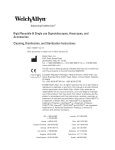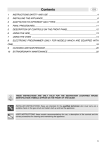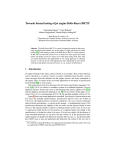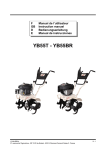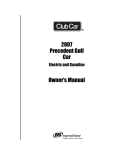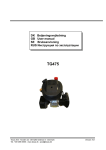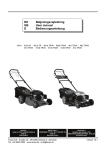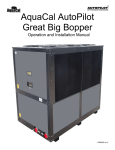Download Pinnacle Speakers TG475-2 User's Manual
Transcript
Assembly and Owner’s Manual TG475-2 Portable Gas Grill L.P. Gas Cylinder Not Included ASSEMBLER / INSTALLER: Leave these instructions with the consumer. CONSUMER / USER: Read all of these instructions and keep them in a safe place for future reference. FOR YOUR SAFETY: If you smell gas: 1. Shut off gas to the appliance. 2. Extinguish any open flame. 3. Open lid. 4. If odor continues, immediately call your gas supplier or fire department. FOR YOUR SAFETY: 1. Do not store or use gasoline or other flammable vapors and liquids in the vicinity of this or any other appliance. 2. An unconnected liquid propane cylinder should not be stored in the vicinity of this or any other appliance. FOR YOUR SAFETY: Never leave a grill unattended when in use. Statement of Commitment Congratulations and thank you for your purchase of your new Great Outdoors grill. We are pleased that you have recognized the value of the design, function and quality of components used in this product. We believe it is among the finest on the market. We are committed to producing quality products that your family will enjoy for years to come. If for any reason we have failed to meet or exceed your expectations, please allow us the opportunity to make it right by calling us toll-free during the following hours: Monday-Friday 8:00 a.m. - 6:00 p.m., EST. United States: 1-800-944-8982 Canada: 1-800-668-5323 (It is recommended to avoid calling on Mondays, when wait times may be prolonged.) We want you to be completely satisfied with your purchase so you will agree with our motto, “there’s nothing like… the great outdoors.”™ CFM Keanall 2695 Meadowvale Blvd Mississauga, Ontario L5N 8A3 Table of Contents Page Number Chapter 1 - INSTALLATION 4 Necessary Information 4 Choosing a Safe Location 4 Portable L.P. Gas Grills L.P. Gas Dealer Instructions Chapter 2 - ASSEMBLY INSTRUCTIONS 5-7 8 9 Step 1 (Identifying Parts) 10 Replacement Parts 11 Step 2 (Cabinet Assembly) 12 Step 3 (Cabinet Assembly) 13 Step 4 (Grill Head) 14 Step 5 (Side Burner Valve) 15 Step 6 (Side Tables) 16 Step 7 (Side Tables) 17 Step 8 (Cooking Grids) 18 Step 9 (Cabinet Doors) 19 Step 10 (Drip Pan) 20 Installing an L.P. Gas Cylinder Chapter 3 - USE and CARE Leak Testing Lighting Instructions 21-22 23 24 25-26 Side Burner Operation 27 Using Your Grill 28 Caring for Your Gas Grill 29 Cleaning and Maintenance 30 Warranty 31 Pinnacle Series Gas Grill Installation Chapter 1 Necessary Information to Safely Use a Gas Grill 2. Installation must conform with local codes or, in the absence of local codes, with either the National Fuel Gas Code, ANSI Z223.1, NFPA 54 (USA), or CAN/CGA-B 149.2 Propane Installation Code (Canada) and CAN/CGA-B 149.1 Natural Gas Installation Code. To check local codes, contact your local gas dealer or gas company listed in the Yellow Pages for recommended installation procedures and regulations. 3. This appliance is not intended to be installed in or on a recreational vehicle and/ or boat. 4. Keep the barbecue grill at least 24 inches (61 cm) away from any combustible construction. • Do not use a grill under a ceiling or cover where the heat or flame could cause damage. • Choose a level surface where the grill is not facing directly into the wind. • Avoid moving the grill during use. Choosing a Safe Location for a Gas Barbecue Grill 5. The grill area must be clear and free from combustible materials, gasoline, and any other flammable liquids or vapors. • Do not use lighter fluid or charcoal briquettes in a gas grill. The flow of combustion and ventilation air is not to be obstructed. The ventilation openings of the cylinder enclosure must be kept free and clear from other debris. Do not store grill covers or other items in the cylinder area. 1. The gas barbecue grill may only be used for cooking out-of-doors. • Do not operate this barbecue in garages, breeze ways, sheds or any enclosed area. • Operating this or any gas-fired appliance in an enclosed area can produce a buildup of carbon monoxide, which could result in injury or death. 4 10. Make sure that the drip pan is in place under the grill bottom. • Hot drippings from cooking food could damage the fuel supply system. IMPORTANT: NEVER leave a grill unattended when in use. Portable L.P. Gas Barbecue Grills 6. Do Not store a spare L.P. gas cylinder under or near this appliance. Do not store an L.P. cylinder in a building, garage or any other enclosed area. Instead, store the cylinder outdoors in a well ventilated area, away from people and out of the reach of children. 7. NOT FOR USE BY CHILDREN • Place your barbecue grill in a location away from children and pets. • Do not leave grill unattended when in use. WARNING: Do not use natural gas in an appliance designed for L.P. gas. Use only liquid propane (L.P.) gas in an appliance designed for L.P. gas. L.P. Gas Liquid Propane (abbreviated L.P.) gas is stored under high pressure inside a cylinder and will vaporize when released. It is important that there are no leaky connections on the grill fuel supply system. Refer to the Leak Testing section of this manual. The L.P. Fuel Supply System An L.P. gas grill requires a fuel delivery system made up of a L.P. gas cylinder, a fuel regulator with hose and a gas-control valve. 8. The outside of the barbecue grill will become hot during use. • To avoid burns, do not touch any hot grill surface. If necessary, use a protective glove when operating control knobs, tank shut-off valve or lid handle. • Do not place combustible material, such as cloth or plastic, on grill surface during use. • Do not lean on side tables or place more than 15 pounds of weight on a side table. 9. The warming drawer is only to be used for keeping food warm. • Do not place any flammable material in the warming drawer. 5 4. The pressure regulator and hose assembly provided is factory set at an outlet pressure of 11 inches water column (.4 lb. per sq. Inch). Side Burner Control Valve Multi-Burner FuelControl Valve Assembly WARNING: Any attempt to adjust the regulator is dangerous and could create a situation causing personal injury or property damage. Consult your L.P. gas dealer if you think the regulator is not working properly. Fuel Supply Hose L.P. GAS SUPPLY CYLINDER L.P. Cylinders can be obtained at the store where you purchased your grill or from an authorized L.P. gas dealer. Type 1 Fuel Regulator The L.P. Fuel Supply System (the fuel regulator and hose) FUEL REGULATOR AND HOSE The fuel regulator supplied is equipped with a Type 1 coupling nut. Do not attempt to connect to any other L.P. cylinder not equipped with a mating Type 1 cylinder valve. This grill is not to be used with any other cylinder connection device. The fuel regulator and hose assembly with the Type 1 fitting supplied must be used with the appliance. Do not use a hose and regulator assembly other than the one supplied with the grill or a manufacturer’s replacement fuel pressure regulator assembly. The Type 1 connection system has the following features: 1. The system will not allow gas to flow until a positive connection has been made. 2. The system has a thermal element that will shut off the flow of gas between 240°F and 300°F. 3. The system has a flow-limiting device which, when activated, will limit the flow of gas to 10 cubic feet per hour. 6 Cylinder Control Valve L.P. Gas Cylinder NOTE: L.P. Gas Cylinder NOT INCLUDED The L.P. Fuel Supply System (L.P. gas cylinder) L.P. GAS CYLINDER SPECIFICATIONS Any L.P. gas-supply cylinder used with this grill must be approximately 12 inches diameter and 18 inches high. The maximum fuel capacity must be 20 pounds of propane. Full-cylinder weight should be approximately 38 pounds (43.7 lbs. Nominal water capacity). The L.P. gas cylinder must have a shut-off valve terminating in a Type 1 L.P. gascylinder-valve outlet. A Type 1 compatible cylinder with a Type 1 cylinder valve has a positive seating connection that does not permit gas flow until a positive seal has been obtained. After filling, have the gas dealer check for leaks and that the relief valve remains free to function. The cylinder must be arranged for vapor withdrawal. It must also include a collar to protect the cylinder valve. A safety-relief device having direct communication with the vapor space of cylinder must be provided. This will expel high-pressure gas if the cylinder is overfilled or overheated. DANGER: a.) Do not store a spare L.P. gas cylinder under or near this appliance. b.) Never fill the gas cylinder beyond 80 percent full. c.) If the information in (a.) and (b.) is not followed exactly, a fire causing serious injury or death may occur. All L.P. gas cylinders used with this appliance shall be constructed and marked in accordance with the specifications for L.P. gas cylinders of the U.S. Department of Transportation (DOT) or the National Standard of Canada, CAN/CSA-B339, Cylinders, Spheres and Tubes for Transportation of Dangerous Goods; and Commission, as applicable; and shall be provided with a listed overfilling-prevention device. Read labels on the L.P. gas-supply cylinder. DANGER: Do not insert any foreign objects into the valve outlet. You may damage the back check. A damaged back check can cause a leak, which could result in explosion, fire, severe personal injury or death. Allow only a qualified L.P. gas dealer to fill or repair an L.P. gas-supply cylinder. Inform the gas dealer if it is a new or used cylinder to be filled. Caution the gas dealer not to overfill the fuel cylinder. Have the gas dealer weigh the cylinder after filling to ensure that the cylinder is not overfilled. TRANSPORTING A FULL CYLINDER WARNING: Handle a full cylinder with care. Gas is under high pressure. You should transport only one cylinder at a time. Transport the cylinder in an upright and secure manner with the control valve turned off and the POL dust cap in place. Do not transport a cylinder in the passenger compartment of a vehicle. Do not leave cylinder in direct sunlight or in a high-heat area such as a closed car trunk. High-heat areas could cause the relief valve to vent gas. Use a cylinder cap on the cylinder-valve outlet during transport and when the cylinder is not connected to the grill. Keep cylinder valve closed when not in use. 7 Take These Instructions to the L.P. Gas Dealer that will not permit gas to flow until an evacuation device is installed. To purge the L.P. gas cylinder, the back-check module must be opened with an evacuation device. When using a cylinder exchange, be sure the exchanged cylinder is a Type 1 cylinder: a 510 POL cylinder will not fit a Type 1 regulator. FILLING AND PURGING TYPE 1 L.P. GAS CYLINDERS PURGING AND EVACUATION DEVICES FOR L.P. GAS CYLINDER WITH TYPE 1 CYLINDER VALVES DANGER: Purging and filling of L.P. gas cylinders must be performed by personnel who have been thoroughly trained in accepted L.P. gas industry procedures. Failure to follow this instruction may result in explosion, fire, severe personal injury or death. A. Hose-end valve with a bleed port: Purging can be accomplished using a hoseend valve containing a bleed port, which also allows for evacuation without the use of an adapter. IMPORTANT: Purge new cylinders before filling. This tank is easily filled with a standard CGA 510 POL filling connection. B. Hose-end valve without a bleed port: When a hose-end valve does not have a bleed port, a separate device must be used for evacuation. C. Purging using a Type 1 connection: L.P. gas cylinder evacuation can be accomplished during each purging by using a Type 1 connection. The Type 1 valve outlet has 1-5/16” external ACME right-hand thread that will accept this connection. CAUTION: After purging or filling an L.P. gas cylinder, do not insert a POL plug into the valve outlet. Insertion of this plug will prevent the back-check from closing. Use ONLY the provided cap and strap attached to the outlet. Close the cylinder valve knob before returning the cylinder to the customer. Filling a Type 1 Cylinder Valve Example A: shows a CGA-510 POL fitting. For proper purging procedures in the USA, refer to: Safety Bulletin NPGA#133, “Purging L.P. Gas Cylinders,” and Safety Bulletin NPGA#130, “Recommended Procedures for Filling Cylinders.” DANGER: Do not fill an L.P. gas cylinder beyond 80% full. If this information is not followed exactly, a fire causing serious injury or death may occur. The L.P. gas cylinder has a Type 1 cylinder valve with a back-check module in its outlet 8 Pinnacle Series Gas Grill Assembly Instructions Chapter 2 Getting Started 1. Please follow the steps in the order that they are presented. 2. Assemble the grill where you plan to use it. 3. You may want to place an old towel or cloth at the assembly site to prevent nuts and bolts from becoming lost. 4. Have a friend help. An assistant can make the assembly easier by holding the parts in place while you fasten the nuts and bolts. 5. To be ready to barbecue immediately, have the L.P. gas cylinder filled by an authorized L.P. dealer or cylinder exchange center. Unpacking the Grill Parts 1. Remove and set aside all inner boxes and parts from the master carton. 2. Remove and set aside all wrapping paper and additional packaging from the parts. 3. Do not destroy carton or packing until your grill is completely assembled and operating to your satisfaction. Tools needed to assemble grill: • Phillips-head screwdriver TOOLS NOT INCLUDED ESTIMATED TIME FOR ASSEMBLY 30 MINS 9









